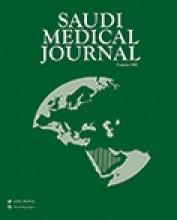Abstract
OBJECTIVES: To examine the changes in emergency department (ED) utilization over a 3-year period and identify the factors that affect utilization.
METHODS: We performed an analysis of administrative ED records at King Abdul-Aziz Hospital from the years 2003 to 2005 for all patients to assess the demographic characteristics, periodicity of ED use, and acuity level.
RESULTS: During the study period, the number of ED visits increased approximately 30%. Patients demographic characteristics, periodicity, and acuity were comparable for ED visits across each study year. Fall (between September and November) was the busiest season (30%), and the greatest volume was between 3 and 11 pm (57.5% of all visits). We found that 52% had 1 visit, 18% had 2 visits, 12% had 3 visits, and 8% had 4 or more visits. The Canadian Triage and Acuity Scale (CTAS) IV and V visits comprised 59.5% of the ED visits. The patients' admission has increased from 7.2-9%, while the ED length of stay increased from 72 minutes to 78 minutes during the study period.
CONCLUSIONS: Emergency department utilization increased during the study period, with almost no change in the proportions for triage category. The numbers of patients requiring hospital admission increased, as the length of their stay. Nearly 60% of emergency visits are for CTAS IV and V care. There were significant patients with multiple visits to ED. We recommend the strengthening of the primary health care in our institution and a designated “Fast Track” in ED for the expeditious management of low acuity patients.
- Copyright: © Saudi Medical Journal
This is an open-access article distributed under the terms of the Creative Commons Attribution-Noncommercial-Share Alike 3.0 Unported, which permits unrestricted use, distribution, and reproduction in any medium, provided the original work is properly cited.






